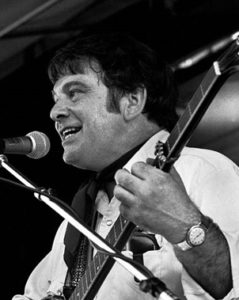Bob Gibson
Bob Gibson was one of the first superstars of the folk revival of the mid-’50s, inspired to perform after seeing Pete Seeger in concert in 1954. Gibson’s clean-cut appearance and accessible presentation paved the way for such commercially viable groups as the Kingston Trio and the Tarriers. His repertoire (initially traditional folk and blues numbers, increasingly augmented by some brilliant original compositions), ringing 12-string guitar, and imaginative instrumental and harmony arrangements as a soloist and in partnership with Hamilton “Bob” Camp (with whom he recorded the first gold album of the folk boom, 1961’s Gibson and Camp at The Gate of Horn), were to leave a major imprint on such young artists as Simon & Garfunkel, Roger McGuinn of the Byrds, Fred Neil, and Phil Ochs (with whom Gibson wrote several songs). In the early ’60s, heavyweight folk manager Albert Grossman suggested that Gibson and Camp add a female voice to their duo; when his suggestion was rejected, Grossman adapted the Gibson/Camp template and assembled Peter, Paul and Mary.
Gibson took great joy in introducing new talent to his audiences, bringing Joan Baez onstage at the 1959 Newport Folk Festival, presenting then-unknown Judy Collins at his familiar Chicago stamping grounds, the Gate of Horn club, and, years later, adding Anne Hills to his long list of protégés.
Although personal problems and folk fans’ preferences for somewhat younger and scruffier performers eventually edged Gibson from the limelight, he remained a vital and creative presence in the folk world until his death in 1996.
Showing the single result


